
As climate change transforms the weather in western Oregon, more and more nursery owners, landscapers and home gardeners are looking for plants that are fully drought-tolerant and cold-hardy. Development of genuinely low-input landscapes will expand the plant palette that can be grown by Oregon’s nursery industry and increase profitability for the best-selling agricultural commodity in the state with almost $1 billion worth of products in 2018, according to the Oregon Department of Agriculture.
Oregon State University Extension Service and the OSU Agricultural Experiment Station both have a long history of assisting the state’s nursery industry. Neil Bell, an Extension community horticulturist, determined he would help again by running plants through an extensive testing process at North Willamette Research and Extension Center (NWREC) in Aurora and the Oregon Garden in Silverton. In 2000, Bell started the trial on Hebe, a genus of flowering shrubs from New Zealand that are very popular – but many of the showiest species and cultivars lack sufficient cold hardiness for use in western Oregon.
“Development of genuinely low-input landscapes for western Oregon will require use of drought-tolerant, evergreen ground covers, few of which are currently used in local landscapes because data on their adaptability to local conditions are not available,” Bell said. “As a result, landscapers tend not to request these plants and nurseries do not grow them in the absence of this data.”
Instead, he said, better known but poorly adapted species are used here that tend not to thrive without significant outputs of water, fertilizer, pesticides and labor. Local evaluations would provide data on plant adaptability to this region and provide nurseries with access to plants for propagation.
In addition to Hebe, Bell has evaluated Cistus, Halimium, Ceanothus, Grevillea and Arctostaphylos to determine plant growth, hardiness and overall quality. In each case, cooperators, both domestic and international, provided plant material that was propagated, grown and planted at NWREC. Data on each plant group was acquired over several years and includes plant size, flowering and overall landscape worthiness, as well as cold hardiness ratings.
The trial planted in 2019 features 80 different broadleaved, evergreen ground covers, some gathered at a nursery in Meze, France. Another evaluation still to be planted will focus on new accessions of Phlomis and Cistus collected at the Plant Heritage collections in Mortehoe, Devon and Leeds in the United Kingdom. Bell has also begun a new evaluation of cold hardiness and growth of 21 Camellia sasanqua cultivars that were planted in 2018 at the Lewis-Brown Horticulture Farm in Corvallis. The second groundcover evaluation was planted at NWREC in November 2021 and included different plants.
All information on the trials is available on the Northwest Plant Evaluations website. Results have been shared with nursery industry publications like Digger, the magazine of the Oregon Association of Nurseries; Nursery Management and Production; and Pacific Horticulture.
Species of the evaluated genera have been used in un-irrigated landscape projects around Marion and Polk counties. As of 2019, seven retail and eight wholesale nurseries in Oregon, Washington and California have taken cuttings and are growing and marketing these cultivars. Xera Nursery in Sherwood, Ore., named and is selling a Grevillea selected from one of Bell’s trials and named it Grevillia ‘Neil Bell’ after him.